Class 11-science H C VERMA Solutions Physics Chapter 11 - Gravitation
Gravitation Exercise 225
Solution 1
F=![]()
F = Gravitational force between two bodies
G = Gravitational constant
m1, m2 = Masses of the two bodies
r = Distance between the bodies
Here, m1=m2=10 kg
G=6.67×10-11![]()
F = ![]()
F = 6.67×10-7N
Solution 2
![]()
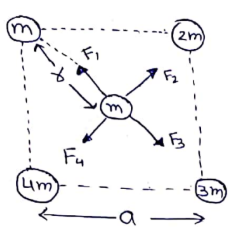
![]()
= ![]() (2)=2k
(2)=2k
![]()
![]()
![]()
![]()
Here ![]() and
and ![]() are on the same
straight line.
are on the same
straight line.
Thus, Resultant force= ![]() -
-![]() [ because
[ because ![]() >
>![]() ]
]
![]() = 6K - 2k = 4K
= 6K - 2k = 4K
![]() and
and ![]() are on the same
straight line.
are on the same
straight line.
Resultant force= ![]() -
- ![]() [because
[because ![]() >
>![]() ]
]
![]() = 8K - 4k = 4K
= 8K - 4k = 4K
Total resultant force ![]() =
= ![]()
Here cos𝜃 = 0 because 𝜃 = 90°

![]() =
= ![]()
![]()
![]()
![]()
Resultant force on 'm' is= 4![]()
Gravitation Exercise 226
Solution 3
Mass 'm' is at mid-point of side PR.
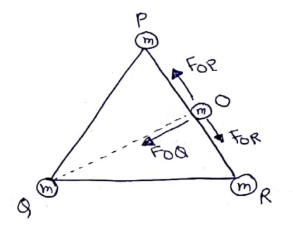
(a) OP = OR = a/2
![]() =
= ![]() K=
K= ![]()
![]() =
= ![]() = 4K
= 4K
![]() =
= ![]() = 4K
= 4K
Altitude OQ = ![]()
![]() =
= ![]() =
= ![]() =
= ![]() K
K
Here, FOP and FOR are equal in magnitude and opposite in direction.
So, FOP + FOR = 0
Total resultant force(F)
= ![]() +
+![]() +
+![]()
= 0 + ![]()
= ![]() K
K
= ![]() (Along OQ)
(Along OQ)
(b) If particle at centroid, All forces 'F' are equal in magnitude.
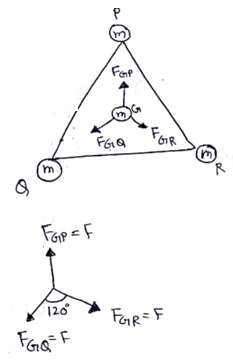
F= FGP = FGQ = FGR
= ![]()
Resultant of FGQ and FGR
FR = ![]()
=![]()
FR =F
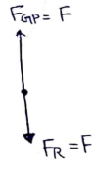
The resultant is 0, because they have equal magnitude and are in opposite direction.
Solution 4
Let us assume that the center of mass of spheres are located at point P, Q and R. So, re-drawing the figure, it is an equilateral triangle.

Force on mass M at point P
FPR = FPQ![]() =
= ![]() = k (let)
= k (let)
Resultant
FR = ![]()
FR =![]()
FR=![]()
FR =![]()
Solution 5
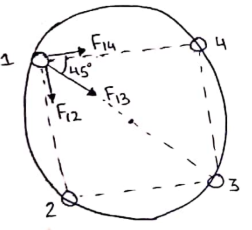
Here,
![]()
![]()
![]()
Now, force on particle 1
Due
to particle 4: ![]()
Due
to particle 2: ![]()
Due
to particle 1: ![]()
Resultant
of ![]()

![]() (along
(along ![]() direction)
direction)
Net
resultant force, ![]()
![]()
![]()
Since particle is revolving in a circle. So, this is centripetal force.
![]()
![]()

Solution 6
The acceleration due to gravity at a point at height 'h' from the surface of moon of radius R is
g
=![]()
=
![]()
= 0.65 m/s2
Solution 7
![]()
Initially,

Finally,
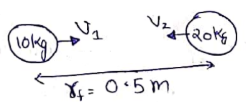
If both bodies are taken as system.
![]()
![]()
![]()
![]()
![]()
Now, applying law of conservation of energy,
![]()
![]()
![]()
![]()
On solving,
![]() m/s
m/s
and
![]() m/s
m/s
Solution 8
Consider two small elements at an angle 𝜃 from horizontal length of the element =Rd𝜃
Mass of each element dm = ![]() (Rd𝜃)
(Rd𝜃)
Force by elemental mass on particle
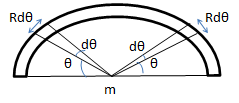
dF = ![]()
dF = ![]()
dF = ![]()
Resultant of the both elemental forces = 2dFsinθ
Net Force
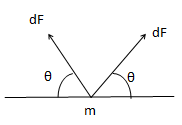
FN =![]()
=![]() sinθ
sinθ
=![]()
= ![]()
FN = ![]() ( because
( because ![]()
Solution 9
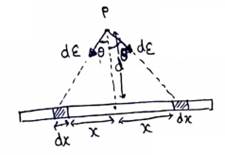
Consider two small elements of length dx at a distance x from center on both sides of center.
Mass of each element, dm = ![]() dx
dx
Field due to each element at point P
=![]()
dE = ![]()
Resultant of the elemental field= 2dE cosθ
Net electric force = ![]()
=![]()
= ![]()
On integrating,
EN = ![]()
Solution 10
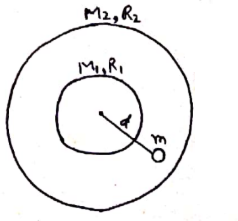
Here, ![]()
The gravitational force of mass m
due to shell of ![]() is zero as gravitational field inside shell
is zero.
is zero as gravitational field inside shell
is zero.
Gravitational field due to shell of
mass ![]() outside the shell at mass m=
outside the shell at mass m=![]()
So, force ![]()

![]()
Solution 11
Method 1:
The gravitational field inside a
sphere of radius R at a distance x from center is ![]()
So, force on particle of mass m is
![]()
![]()
Method 2:
Acceleration due to gravity at depth d from surface
![]()
Here, ![]()
![]()
![]()
So, force on particle of mass m is= mg
![]()
![]()
Solution 12
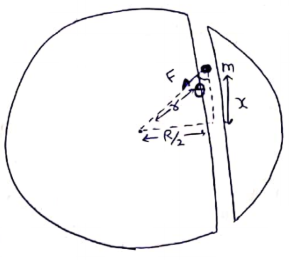
Distance of the particle from earth's center

Force on the particle=mass![]() gravitational
field intensity
gravitational
field intensity
![]()
![]()
Force exerted by wall on particle=Force exerted by particle on wall
![]()
![]()
![]()
Solution 13
(a)
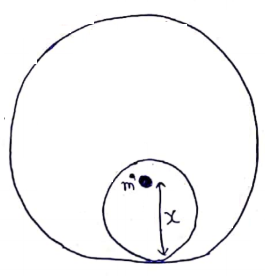
Gravitational field intensity inside
shell is zero. So, force by shell on mass ![]() is zero.
is zero.
Now, for solid sphere.
Gravitational field inside sphere at a distance (x-r) from center is
![]()
So, force by sphere on mass ![]() is
is
![]()
Net force
![]()
![]()
(b)
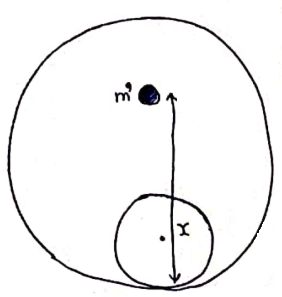
Gravitational field intensity inside
shell is zero. So, force by shell on mass ![]() is zero.
is zero.
Now, for solid sphere.
Gravitational field intensity outside sphere at distance (x-r) is given by
![]()
So, force by sphere on mass ![]() is
is
![]()
![]()
Net force
![]()
![]()
(c)
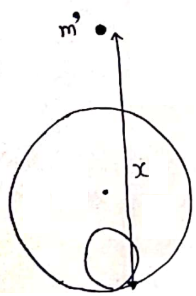
Force=mass![]() Gravitational
field intensity
Gravitational
field intensity
Force by shell=![]() (towards center)
(towards center)
Force by sphere=![]() (towards center)
(towards center)
![]()
![]()
Solution 14
(a) At point ![]()
Net gravitational field=field due to shell+ field due to sphere
![]()
![]()
(b) At point ![]()
Net gravitational field=field due to shell+ field due to sphere
![]()
![]()
![]()
Solution 15
Resultant field inside any spherical shell is zero at all points. So, at point a and B, field is zero. The field due to upper part and lower part and are equal and opposite.
Solution 16

Let mass 0.5kg is placed at distance x from 2kg between both masses.
Since, particle is in equilibrium.
Force due to 2kg= Force due to 4kg
![]()
On solving,
x=0.83m
Now, gravitational potential energy
![]()
![]() J
J
Solution 17
Work done
=ΔU = final P.E - initial P.E
=Uf -Ui
=3(![]() ) - 3(
) - 3(![]() )
)
=(![]() )
)
Solution 18
Work done against gravitational force = change in potential energy
![]()
![]()
![]()
![]() J
J
Solution 19
![]()
(a) Force, ![]()
![]()
![]()
![]() N
N
(b) ![]()
![]()
![]()
![]()
at (0,0), potential =0
![]()
C=0
So, V=-5x-12y
At point (12,0)
![]()
At point (0,5)
![]()
(c) Potential at (12,5)
![]()
and potential at (0, 0) is 0.
So, change in gravitational potential energy
![]()
![]()
![]()
(d) ![]()
![]()
Gravitation Exercise 227
Solution 20
![]()
Dimension of L.H.S =[V]
![]()
![]()
![]()
Dimension of RHS=![]()
![]()
Hence, dimensionally correct.
(b) ![]()
![]()
![]()
![]()
(c) ![]()
![]()
![]()
![]()
Solution 21
Gravitational field in the region is given by
E = 2 î + 3![]()
Slope of gravitational field, m1 = tanθ1 = 3/2
The
line 3 y + 2 x = 5 can be written with the slope, m2 = ![]() 2
= -2/3
2
= -2/3
m1 × m2 = -1
Thus, m1, m2 lines are perpendicular.
So, no work is done in by gravitational force when a particle is moved on the given line.
Solution 22
Let height be h
![]() =
= ![]()
2![]() =
= ![]()
![]()
h = (![]() -1)R
-1)R
Solution 23
g'=g (1- ![]() )
)
g' be the acceleration due to gravity at Mount Everest
h=8848
g'=9.8×(1- ![]() )
)
= 9.77 m/s2
Solution 24
g'= g(1- ![]() )
)
g' be the acceleration due to gravity at surface
= 9.8×(1- ![]() )
)
=9.79 m/s2
Solution 25
Let gp be the gravity at the poles ,ge be the gravity at the equator
ge= gp - ω2R
=9.81 - ![]()
= 9.766 N/m2
Now, mge = 1kg × 9.766 N/m2
=9.766 N
Thus the body weighs 9.766 N at the equator.
Solution 26
At equator, let stretch in spring be x
Spring force=![]()
![]() -(1)
-(1)
Now, at height h above surface, stretch in spring is x
Spring force=![]()
![]() -(2)
-(2)
From (1) and (2)
![]()
![]()
![]()
![]()
![]() Km
Km
Solution 27
Apparent acceleration due to gravity at equator becomes 0.
G'=g - ω2R = 0
g = ω2R
ω= ![]()
=![]()
= 1.2![]() rad/s
rad/s
Time period = T = ![]() =
= ![]() = 1.41 hrs
= 1.41 hrs
Solution 28
(a) Since, ship is at rest with respect to water.
So, Angular speed of ship=Angular speed of earth
![]()
![]()
![]()
(b) The tension in string is given by
![]()
![]()
(c) If ship sails at speed v, then tension
![]()
![]()
![]()
![]()
![]() [Here
R>>>V
[Here
R>>>V ![]() ]
]
![]()
Solution 29
Kepler's law of planetary motion says ,
T2 ∝ R3
![]() =
= ![]()
![]()
![]() =
= ![]() = 1.52
= 1.52
Solution 30
Time period of the moon around the earth is given by,
T =2π![]()
m = mass of earth
r = Distance between center of the moon and earth
27.3 × 86400= 2×3.14![]()
M = ![]() kg
kg
Solution 31
Time period of revolution of satellite around the mars is given by
T =2π![]()
M = Mars mass
r = Distance of the satellite from center of the planet
27540 = 2×3.14![]()
M = 6.5 × 1023kgs
Solution 32
(a) Speed of satellite in its orbit
V0=![]()
V0=![]() = 6.9 km/sec
= 6.9 km/sec
(b) Kinetic energy of satellite =
(½)×1000×![]()
= 2.38×![]()
(c) Potential energy of satellite =
P.E = ![]()
=![]()
= -4.76![]() J
J
(d) Time period of the satellite
![]()
![]()
T=7645.2 sec
![]() =2.1 hrs
=2.1 hrs
Solution 33
(a) Since, angular speed of satellite is equal to angular speed of earth.
So, time period of satellite=24hrs
T=24hrs



h=42300 Km
(b) Time taken from North pole to equatorial plane
![]() hrs
hrs
Solution 34
Weight at North pole = 10 N
W = mg
10 = mg
Weight of body in a satellite at height 'h' is
WS =mg'
= m [g (![]() ]
]
For a geo-stationary satellite, R = 6.4×103 km
h = 3.6 ×103 km
![]() N
N
Solution 35
Time period of the revolution of the satellite around a planet in terms of the radius of the orbit of the satellite is given by:
T =2π![]()
T2 =4 π2 (![]()
g =![]()
Where 'g' is acceleration due to gravity.
Solution 36
Consider that 'B' is the position of the geo- stationary satellite.
Here R= 6400 kms ( Radius of earth)
d = altitude
θ = colatitude of the plane which can directly receive a signal from the satellite.
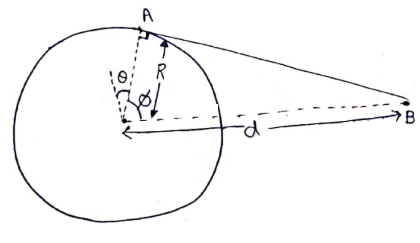
![]() Take ∆OAB,
Take ∆OAB,
cos 𝜙 = ![]() =
= ![]()
𝜙 = ![]()
= ![]() (0.15)
(0.15)
Now θ + 𝜙 = ![]()
θ = ![]() -
- ![]()
θ =![]()
Solution 37
Upon Earth's surface, its total energy is
E = K.E +P.E
=![]() mv2 +(-
mv2 +(-![]() (1)
(1)
In space at maximum height , its K.E
=0 and P.E =-![]()
Es = 0+ ![]() (2)
(2)
Total energy must be conserved , therefore (1) = (2)
![]() mv2 +(-
mv2 +(-![]() =
= ![]()
Here h= R, so
![]() mv2 =
mv2 = ![]() (
( ![]()
![]() mv2 =
mv2 = ![]()
V= ![]()
=![]()
= 7.9 km/s
Solution 38
Velocity of particle on the Earth surface = Ve = 15 km/s
Let Vs be the particle velocity in space.
Total Energy must be conserved.
Change in K.E. = Change in P.E.
∆K.E.=∆P.E.
![]() m(
m(![]() ) =
) =![]()
![]() [(225) -
[(225) - ![]() ] =
] = ![]()
On solving
Vs = 10 km/s
Solution 39
Escape velocity = Ve
=![]()
Mass = 6× 1024 kgs.
Ve = 3×108 m/s.
i.e., 3×108= ![]()
On solving,
R = 8.89×10-3
=9×10-3
= 9mm.

